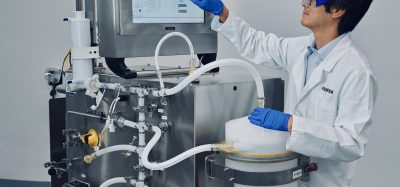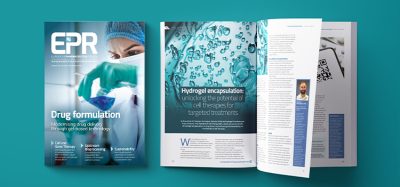Under the Microscope: John Comer, Sirius Analytical
Posted: 18 December 2012 | | No comments yet
John Comer, Chief Scientific Officer at Sirius Analytical, discusses particle size analysis and characterisation.
Sirius Analytical was founded in 1989 with the goal to become a world-class manufacturer of innovative instrumentation for chemical analysis. Today, Sirius Analytical makes instruments to measure the physicochemical properties of drugs, specifically pKa, logP, solubility and dissolution. The current gold standard for Sirius Analytical is the SiriusT3, a third generation physchem measurement system.
“When we were developing the SiriusT3, we knew that scientists had less sample weight available to make physchem measure ments, so we miniaturised key components to facilitate titration experiments in just 1.5 mL volumes,” explains John Comer, Chief Scientific Officer, Sirius Analytical. “This led to the greatest benefit of the SiriusT3; it makes pKa, logP and solubility measurements using quite small amounts of sample. We can measure pKa by the pH-metric technique using half a milligram of sample while we need only a few micrograms to measure pKa by UV. The other benefit of a third generation technology is that we learned a lot about how to improve performance from customers and users of the first two generations and all that experience is built into the SiriusT3.”
John Comer, Chief Scientific Officer at Sirius Analytical, discusses particle size analysis and characterisation.Sirius Analytical was founded in 1989 with the goal to become a world-class manufacturer of innovative instrumentation for chemical analysis. Today, Sirius Analytical makes instruments to measure the physicochemical properties of drugs, specifically pKa, logP, solubility and dissolution. The current gold standard for Sirius Analytical is the SiriusT3, a third generation physchem measurement system.“When we were developing the SiriusT3, we knew that scientists had less sample weight available to make physchem measure ments, so we miniaturised key components to facilitate titration experiments in just 1.5 mL volumes,” explains John Comer, Chief Scientific Officer, Sirius Analytical. “This led to the greatest benefit of the SiriusT3; it makes pKa, logP and solubility measurements using quite small amounts of sample. We can measure pKa by the pH-metric technique using half a milligram of sample while we need only a few micrograms to measure pKa by UV. The other benefit of a third generation technology is that we learned a lot about how to improve performance from customers and users of the first two generations and all that experience is built into the SiriusT3.”
John Comer, Chief Scientific Officer at Sirius Analytical, discusses particle size analysis and characterisation.
Sirius Analytical was founded in 1989 with the goal to become a world-class manufacturer of innovative instrumentation for chemical analysis. Today, Sirius Analytical makes instruments to measure the physicochemical properties of drugs, specifically pKa, logP, solubility and dissolution. The current gold standard for Sirius Analytical is the SiriusT3, a third generation physchem measurement system.
“When we were developing the SiriusT3, we knew that scientists had less sample weight available to make physchem measure ments, so we miniaturised key components to facilitate titration experiments in just 1.5 mL volumes,” explains John Comer, Chief Scientific Officer, Sirius Analytical. “This led to the greatest benefit of the SiriusT3; it makes pKa, logP and solubility measurements using quite small amounts of sample. We can measure pKa by the pH-metric technique using half a milligram of sample while we need only a few micrograms to measure pKa by UV. The other benefit of a third generation technology is that we learned a lot about how to improve performance from customers and users of the first two generations and all that experience is built into the SiriusT3.”
Particle size analysis is another key property which affects many attributes of the active pharmaceutical ingredient, formulation intermediates such as granules and the dosage form itself. “Funda mentally, it can affect the dissolution of the drug substance – and of course dissolution is one of our longstanding interests,” says Comer. “For respiratory products, particle size is enormously important in ensuring that drug particles reach the site of action. Particle size also affects the performance of the drug product in other ways, such as influencing content uniformity, stability or water sorption for example. It can also affect a pharmaceutical company’s ability to manu – facture the product by influencing powder flow or compaction properties during the manufacturing process.”
Sirius Analytical has just launched Sirius Insight, a new innovative particle size analyser that makes particle size measurements easier, more meaningful and robust. “The technology combines two independent channels to give a high degree of insight into particle properties, which in itself is of huge benefit,” Comer explains. “The measurement of size on the Insight is performed in a very different way to most particle size instruments. The laser obscuration time technique measures size on a particle by particle basis, determining the time that a rotating, focused laser beam is obscured by each particle. Because we know the rotational speed of the laser beam accurately, we can calculate the distance from one side of the particle to the other.” The Insight does not assume particle shape and the determination of size doesn’t require knowledge of the particle’s optical properties and an optical model is not required for the calculation of size. “The Insight is ideally suited to the measurement of heterogeneous mixtures as well as pure compounds and it can be applied with ease to polymodal distribu – tions since it is not dominated by large, high volume particles, as can be the case with other techniques,” Comer continues. “We think that there are a lot of very real benefits to measuring particle size in this way. Many practitioners of particle size analysis techniques have long wished to be able to see the particles that they are measuring when making size measurements. While this often has to be done separately on a difference particle population to that used for the size measurement, the Insight gives the user live video images of the sample dispersion during measurement. It gives the user the answers to questions like is the sample well dispersed, does it agglomerate or fracture during measure ments and is the dispersion stable? The imaging ability of the Insight enables the analyst to utilise image analysis to generate up to 40 different shape factors, any of which may have a specific correlation to product or process performance. It really does introduce another dimension to particle characterisation.”
“It’s getting harder to discover small molecule drugs and bring them to market successfully,” he explains. “Attrition rates are high, research costs are enormous and yet healthcare providers are reluctant to pay high prices for new drugs. Generics companies take over the business when blockbusters come off patent and when discovery scientists can’t replace them, big Pharma has to scale back. Big Pharma has the skills required to bring new APIs to market, but there’s more discovery going on in universities, independent teams and start-ups who realise their assets when they can sell successful structures. Analytical work, formulation and clinical trials are increasingly outsourced and the area has become very competitive. Weak discovery pipelines have forced companies to pursue research into compounds that might have been passed over 10 years ago due to poor bioavailability, using modern formulation techniques to push them through the bio – pharmaceutics hurdles. In parallel with work on small molecules, lots of research is underway in biopharamaceutics to improve forumations and develop new delivery routes.”






